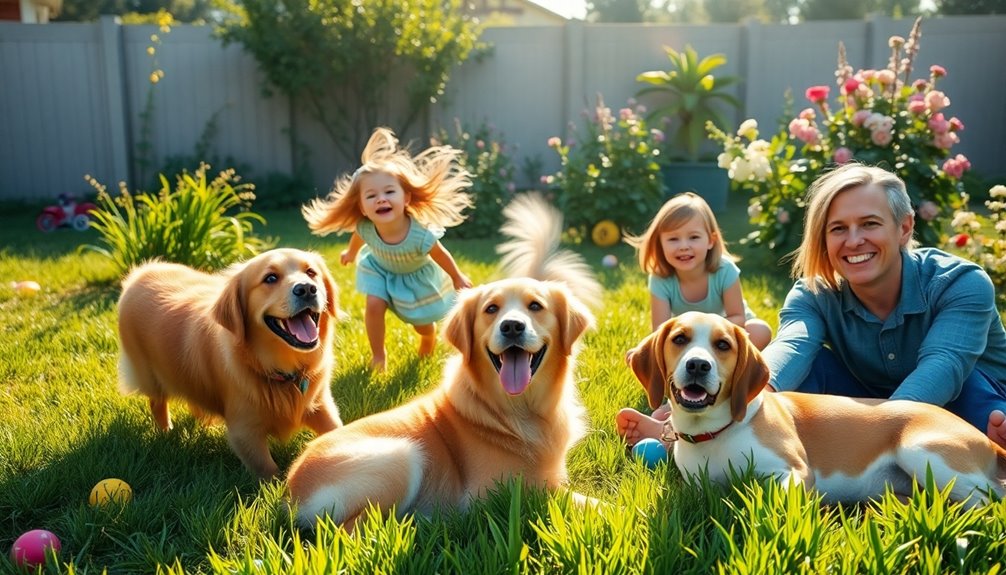If you're looking for the best family-friendly dog breeds, consider options like Labradors, Golden Retrievers, and Beagles. These breeds are known for their friendly nature and adaptability to family life. They thrive on exercise, making outdoor play a central part of your family routine. Boxers and Bulldogs also bond well with children and fit various lifestyles. Remember to assess energy levels, space, and your family's dynamics when choosing a breed. By understanding each breed's unique traits, you can guarantee a harmonious home. There's a lot more to uncover about finding the ideal canine companion.
Key Takeaways
- Labrador and Golden Retrievers are renowned for their friendly nature and make excellent companions for families with children.
- Beagles require daily exercise, promoting active playtime and engagement with the family.
- Boxers are playful and protective, bonding closely with kids and thriving in energetic households.
- Bulldogs adapt well to various environments and possess a calm demeanor, ideal for relaxed family lifestyles.
- Poodles are intelligent and trainable, making them suitable for families while fitting into different living situations.
Top Family-Friendly Breeds

When it comes to choosing a family-friendly dog, five breeds consistently stand out for their compatibility with children and family life.
First up, Labrador Retrievers are beloved for their friendly and social nature, making them fantastic companions for families with children. Their life expectancy is around 12-14 years, giving your family plenty of time to bond.
Next, Golden Retrievers are another excellent choice. They're highly trainable and thrive on regular exercise and mental stimulation, which keeps them happy and engaged.
Beagles, with their merry disposition, are great for active families and need daily exercise to avoid boredom.
Boxers bring a playful energy to any household. They're protective and form strong bonds with kids, but they require regular physical activity to stay content.
Finally, Collies are known for their intelligence and loyalty. They adapt well to family life and benefit from regular outdoor exercise and companionship.
These dog breeds not only make great companions but also enrich family life, ensuring that everyone, including your furry friend, stays active and happy.
Characteristics of Family Dogs

Family dogs often share a few key characteristics that make them ideal companions for households with children. These traits not only foster a loving environment but also guarantee that both kids and dogs thrive together.
| Characteristic | Description | Importance for Families |
|---|---|---|
| Affectionate Nature | Family dogs are loving and form strong bonds. | Enhances emotional connections with children. |
| High Energy Levels | Many breeds are active and enjoy playtime. | Encourages outdoor activities and exercise for the whole family. |
| Trainability | Good family dogs learn commands easily. | Guarantees safe interactions and smooth integration into family life. |
| Health & Grooming | Their needs must align with your lifestyle. | Helps manage exercise, grooming, and health issues effectively. |
| Lifespan Considerations | Understanding longevity is crucial. | Guides commitment and care throughout the dog's life. |
When considering a dog for your family, keep these characteristics in mind. They not only create a joyful environment but also guarantee a harmonious relationship between your dog and children, enhancing your family's overall experience.
Benefits of Dog Companionship
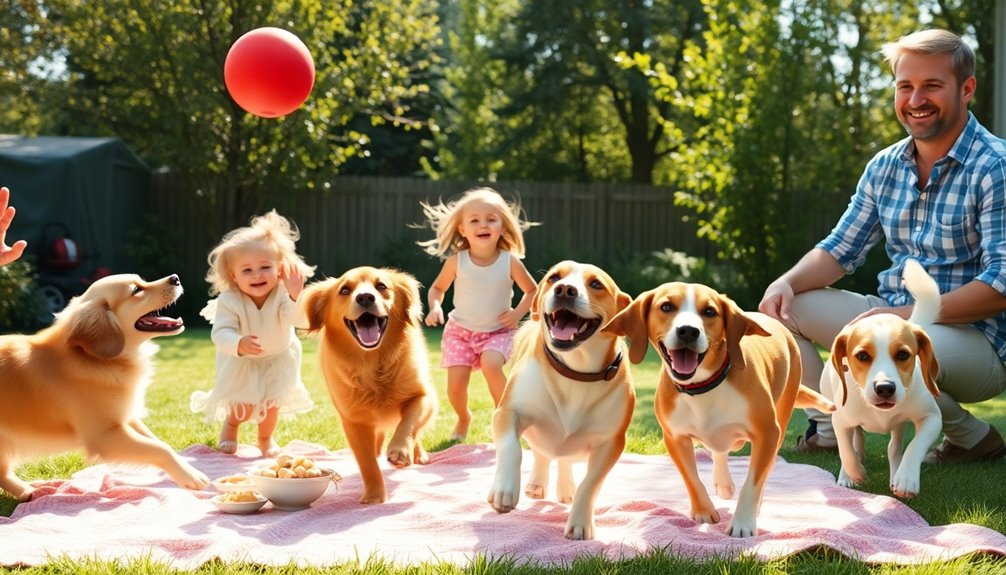
Having a dog by your side offers incredible emotional support, helping you feel less lonely and anxious. Plus, their playful nature encourages you and your family to stay active, making regular walks and playtime a fun routine. With a furry friend, you'll not only improve your mood but also boost your family's overall fitness and well-being. Additionally, dogs can enhance your bond with family members, fostering stronger connections among loved ones.
Emotional Support and Stability
Embracing the companionship of a dog can profoundly enhance your emotional well-being and stability. Dogs offer unconditional love and support, markedly reducing feelings of loneliness and depression. When you pet a dog, studies show your cortisol levels drop while serotonin rises, creating a more positive emotional state.
For families, having a dog serves as a source of comfort during tough times. Emotional support dogs can be trained to recognize signs of distress, providing reassurance when you need it most. This bond not only benefits adults but also helps children develop empathy and social skills. Caring for a pet fosters a sense of responsibility and nurturance, which is essential for personal growth.
Moreover, the presence of a dog encourages you and your family to engage in activities together, promoting a healthier lifestyle. While this will be explored in more detail later, it's worth noting that the physical activity linked to dog ownership contributes to better mental health outcomes, reducing anxiety levels.
Fundamentally, dogs aren't just companions; they play a significant role in enhancing emotional support and stability for families.
Active Lifestyle Encouragement
With a dog by your side, you'll naturally find yourself more active and engaged in outdoor activities. Having a furry companion encourages regular exercise, making it easier for active families like yours to bond through hikes, runs, or simple playtime in the park. Breeds such as Labrador Retrievers and Golden Retrievers are especially good with children, inspiring everyone to get moving and enjoy the great outdoors together.
The benefits of dog companionship extend beyond physical activity. You'll also experience:
- Increased social interactions with fellow dog owners
- Improved mental stimulation for both you and your kids
- A stronger sense of community through shared experiences
Owning a dog instills healthy habits in children, teaching them the importance of responsibility while getting them excited about exercise.
As you engage in daily walks or playful games, you'll notice that the routine helps lower stress levels, leading to a happier, healthier family life. Embracing an active lifestyle with your dog not only promotes physical well-being but also nurtures emotional connections, creating cherished memories for years to come.
Choosing the Right Breed
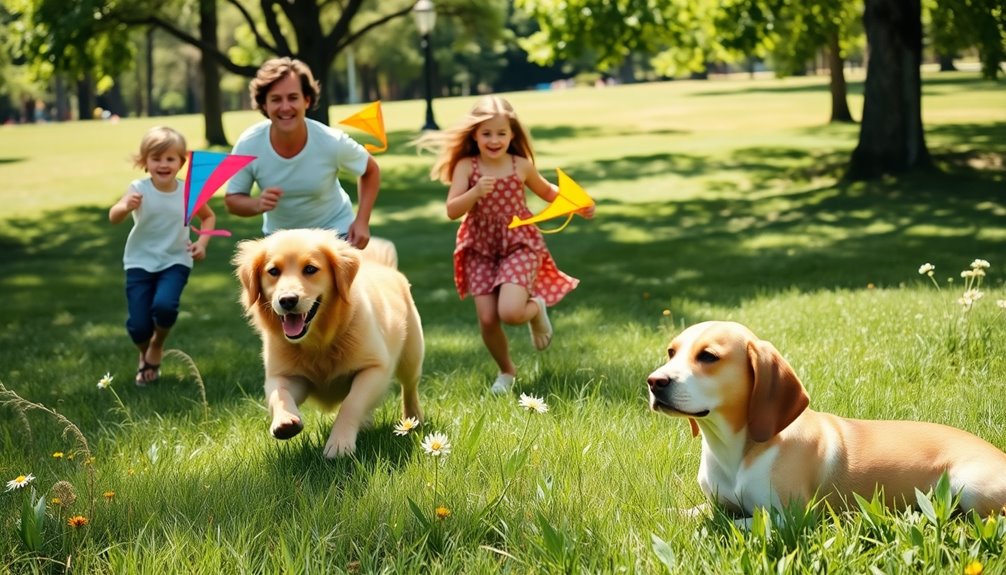
When choosing the right dog breed for your family, think about your children's ages and activity levels.
Some breeds thrive in active households, while others may be better suited for a quieter environment.
Assessing Family Dynamics
Choosing the right dog breed for your family involves carefully reviewing dynamics, including the ages and activity levels of your children. Understanding these factors will help guarantee compatibility and harmonious living with your new furry friend.
Consider the following when evaluating your family dynamics:
- Patience: Breeds like Labrador Retrievers and Golden Retrievers are known for their gentle temperament, making them ideal for families with young kids.
- Energy: If you have older children who are active, energetic breeds like Boxers and Border Collies thrive on engagement and physical activity.
- Living Environment: Your home's size and location matter. Smaller breeds often fit better in apartments, while larger breeds may need more space to roam.
Additionally, think about a dog's trainability. Choosing breeds that are easy to train and adaptable can foster positive interactions within the family. For instance, breeds like the Doxie-Poodle mix are highly trainable and form strong bonds with their owners, making them a great choice for families.
Activity Level Considerations
Understanding your family's activity level is essential for selecting the right dog breed, as each breed has distinct exercise needs that can greatly impact your home life.
If your family is active and enjoys outdoor activities, breeds like Labrador Retrievers and Boxers might be a perfect fit. These dogs have high energy levels and require plenty of playtime and mental stimulation to thrive.
On the other hand, if you prefer a more relaxed lifestyle, consider low-energy breeds like Bulldogs or Basset Hounds. These dogs typically need less intense exercise and can make good companions for families looking for a laid-back pet.
It's also worth noting that smaller breeds can sometimes fit well into both categories, depending on their individual needs. For example, a small, energetic breed like a Jack Russell Terrier requires regular activity to keep its energy in check, while a calm breed like a French Bulldog may be content with short walks.
Ultimately, matching the dog's activity level with your family's lifestyle guarantees a harmonious home, where both you and your new furry friend can enjoy each other's company without the stress of unmet exercise needs.
Training Tips for Families
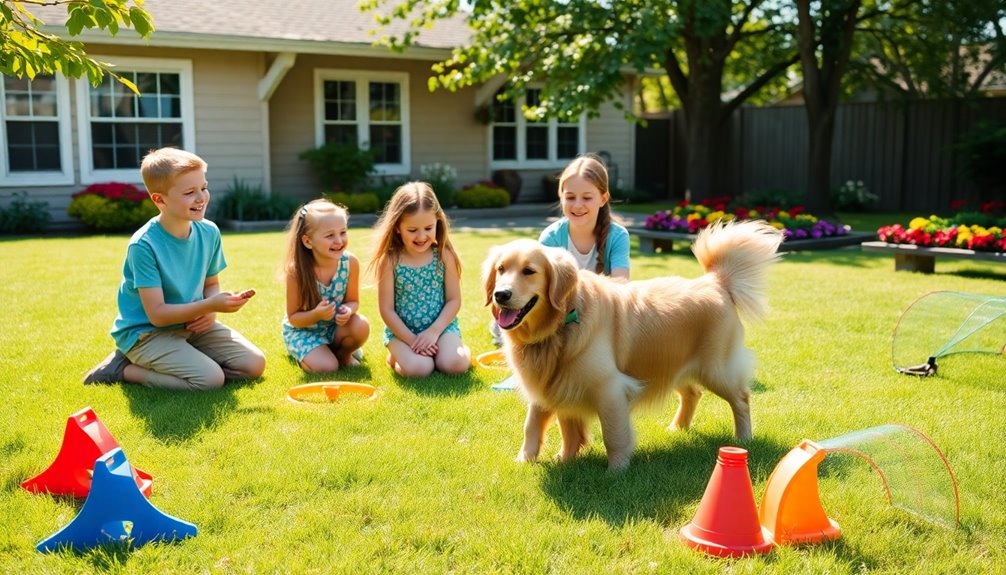
Training a family-friendly dog can be a rewarding experience for everyone involved. Start early—puppies are most receptive to learning during their critical socialization period, which lasts until about 16 weeks. Use positive reinforcement techniques like treats and praise to encourage your dog, making training not just effective but also fun!
Involve all family members in the training sessions. This helps your dog build strong bonds and enhances its responsiveness. Keep the sessions short and engaging, around 5-10 minutes, especially for high-energy breeds.
Here are some quick training tips to keep in mind:
- Celebrate small victories: Every command mastered is a step forward.
- Make it a family affair: Everyone's involvement fosters affection and teamwork.
- Stay consistent: Consistency helps your dog learn faster and feel secure.
Gradually introduce new commands, allowing your dog to master each one before moving on. This approach not only builds confidence but also reinforces a sense of accomplishment.
With these tips, you'll find that training your affectionate small dog will be an easy and enjoyable journey for the whole family!
Grooming and Care Needs
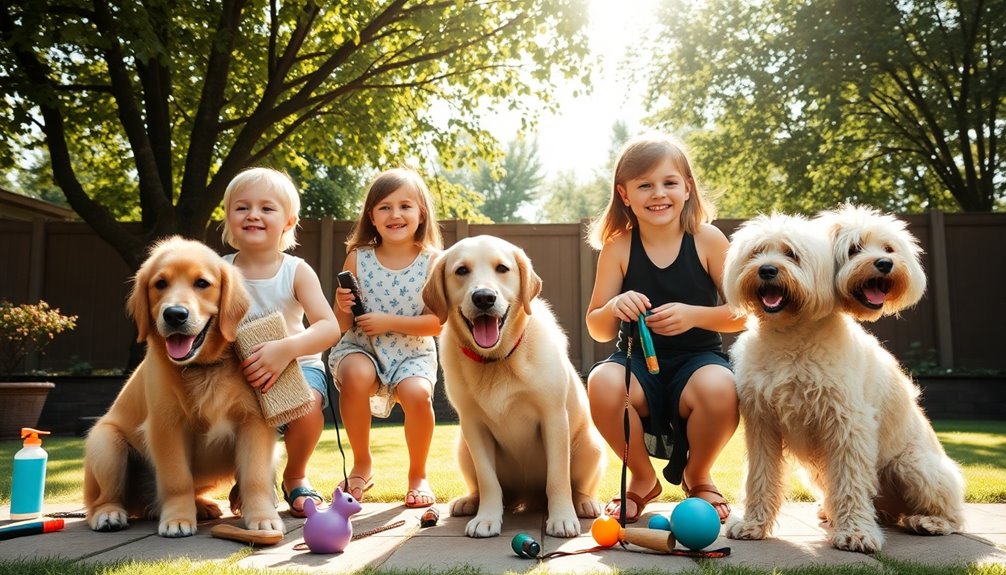
When it comes to grooming and care, each dog breed has its own unique needs that you should consider.
Regular brushing, bathing, and maintenance of nails and ears are essential to keep your furry friend healthy and happy.
Knowing what your breed requires will help you establish a grooming routine that fits your lifestyle.
Grooming Frequency Requirements
Grooming frequency requirements vary considerably among family-friendly dog breeds, making it essential to choose one that fits your lifestyle. If you're a busy parent or have a hectic schedule, consider how much time you can dedicate to grooming.
Here are some breeds with different grooming needs:
- Low-shedding dogs like the Bichon Frise and Poodle require grooming every 4-6 weeks to maintain their coats and prevent matting.
- Breeds such as Collies and Golden Retrievers need brushing 2-3 times a week to manage their longer fur, especially during shedding seasons.
- Bulldogs have a moderate grooming need, requiring weekly brushing and regular cleaning of their facial folds to avoid skin issues.
On the other hand, Beagles and Labrador Retrievers are low-maintenance with just weekly brushing needed, while Old English Sheepdogs and Newfoundlands need more frequent grooming, often requiring professional help every 6-8 weeks.
Knowing these grooming requirements can help you make a thoughtful choice when selecting the perfect family-friendly dog breed for your household.
Bathing and Brushing Tips
Understanding the grooming frequency of family-friendly dog breeds naturally leads to the specifics of bathing and brushing techniques.
Regular brushing is essential, especially for breeds like collies, as it helps prevent matting and reduces loose hair in your home. During shedding season, you'll want to brush your dog more frequently to keep their coat healthy and manageable.
Bathing should generally be done every 6-8 weeks, but adjust as needed based on your dog's activity level and coat condition. Always use a gentle dog shampoo to maintain coat health and avoid skin irritation.
For shaggy breeds like the Bearded Collie, a slicker brush and comb are vital for detangling their fur effectively.
Nail and Ear Care
Keeping your dog's nails and ears in check is vital for their overall health and comfort. Regular grooming not only helps prevent discomfort but also keeps your affectionate companion happy. Aim for nail trimming every 3-4 weeks, especially if your dog is active. Ignoring this can lead to mobility issues and pain.
For ear cleaning, check your dog's ears weekly for dirt and wax buildup. This is important for breeds with floppy ears, as they can trap moisture, leading to infections. Use a veterinarian-recommended cleaning solution, and avoid cotton swabs that may push debris deeper into the ear canal.
Consider these tips for effective nail and ear care:
- Use dog-specific nail clippers or grinders to prevent pain.
- Seek help from a veterinarian or groomer if you're unsure about nail trimming.
- Regularly inspect ears, especially after baths or swimming, to guarantee they stay clean.
Activity Levels and Exercise
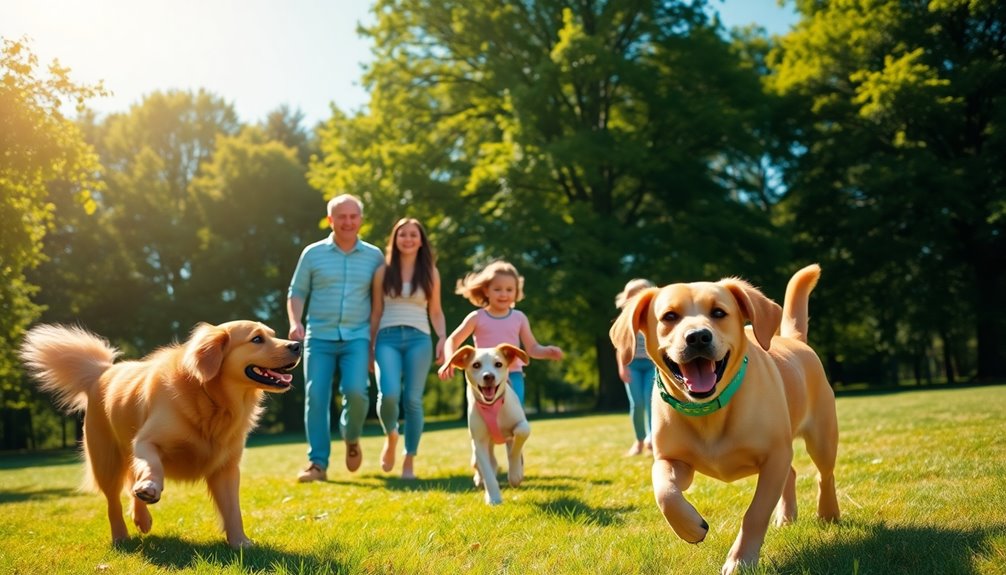
How do you choose the right dog breed for your family's lifestyle? Understanding the activity levels of different breeds is key.
If your family enjoys an active lifestyle, breeds like Labrador Retrievers and Golden Retrievers could be a great fit. These dogs require regular exercise and playtime to keep them happy and healthy. Poodles, both Standard and Miniature, also thrive on physical activity and mental stimulation, making them perfect companions for active families.
On the other hand, if your family prefers a more relaxed approach, breeds such as Bulldogs and Basset Hounds have lower activity needs. They typically require only regular walks and moderate playtime, fitting well into a laid-back lifestyle.
Boxers, while energetic, are playful and thrive on engagement, making them ideal for families with older children who can keep up with their needs.
Lastly, the Newfoundland is another excellent choice, requiring moderate exercise and enjoying water activities. If you live near lakes or oceans, this breed can make a splash in your family outings.
Choosing a breed that matches your family's activity levels guarantees a happy, harmonious home for everyone.
Dogs and Children Safety
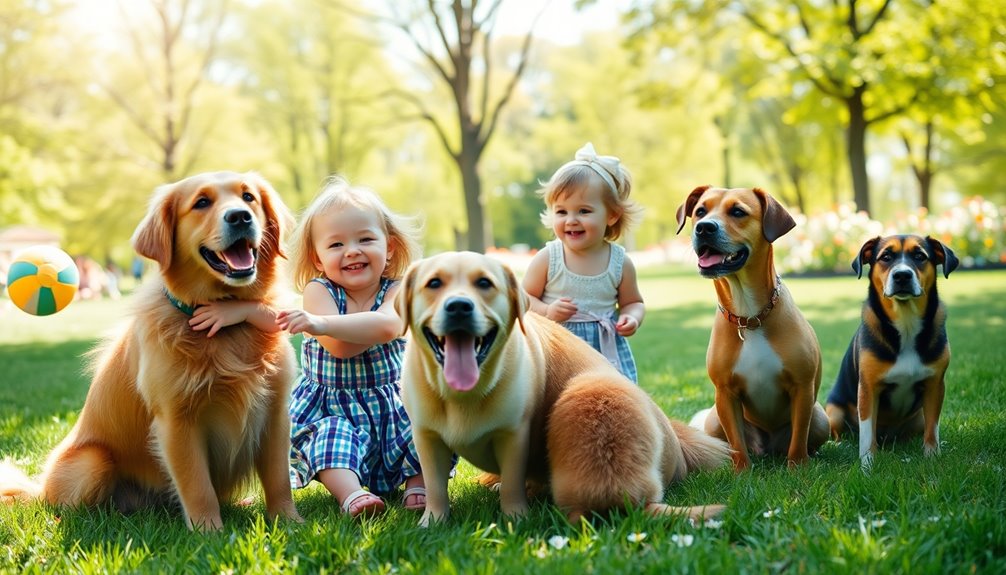
Choosing a dog that fits your family's lifestyle involves more than just activity levels; safety is a top priority, especially when kids are involved.
When considering a dog, opt for breeds known for their gentle temperament, like Labrador Retrievers or Golden Retrievers. They're affectionate and great with children, but supervision is essential.
Here are a few key points to remember:
- Always supervise interactions between dogs and young children to prevent mishaps.
- Teach your kids about canine body language to promote respectful interactions.
- Establish basic training commands for your dog to guarantee they respond well to your children's actions.
- Additionally, understanding canine body language can help prevent misunderstandings and enhance safety during interactions.
Finding a Dog Rescue
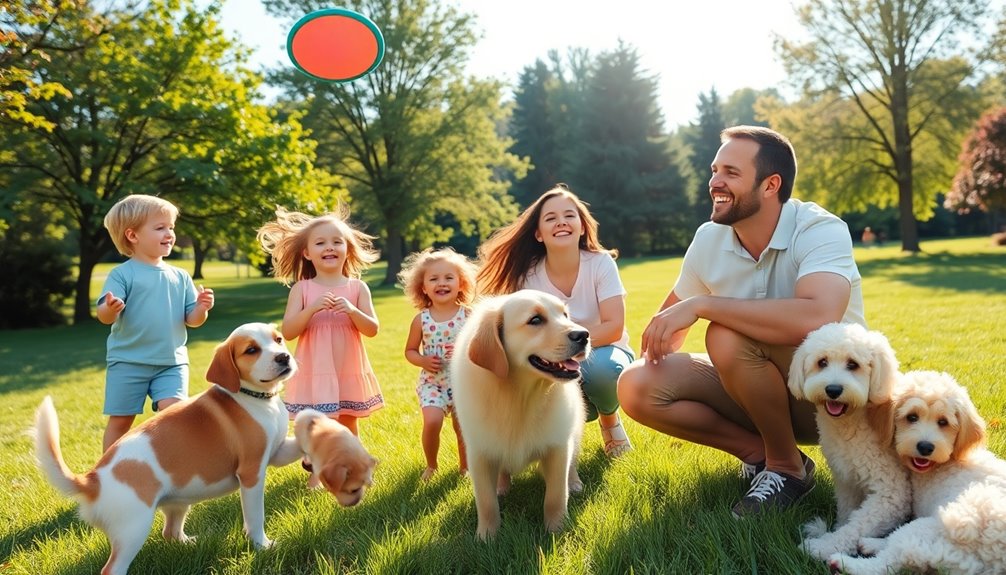
When you're ready to bring a dog into your family, finding the right rescue organization can make all the difference.
Start by researching local dog rescues and shelters using websites like Petfinder or Adopt a Pet. This helps you discover great family-friendly breeds available for adoption in your area.
Look for rescue organizations that specialize in specific breeds, as many have foster programs where you can spend time with dogs in a home environment.
Attending adoption events hosted by rescues is another fantastic way to interact with various dogs. You'll learn about their temperaments and which ones are better suited for a family atmosphere.
Before making a decision, check the rescue's reputation by reading reviews and testimonials from previous adopters. This guarantees they prioritize the health and well-being of their animals.
Don't hesitate to ask questions about a dog's history, behavior with children, and any specific needs. This information is vital in finding a dog that won't only fit into your household but also make an excellent family companion.
Dogs in Family Life
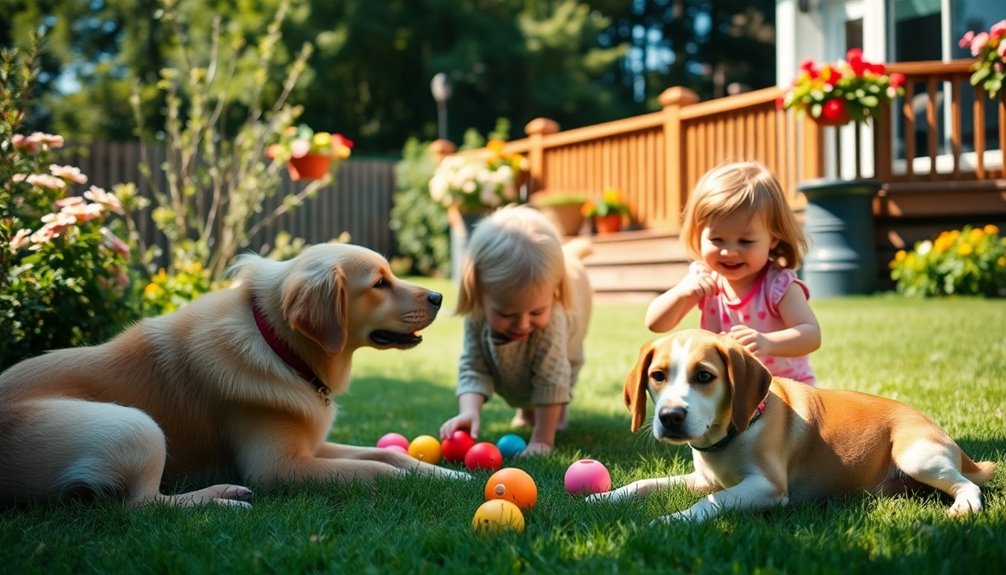
Bringing a dog into your family not only adds a furry companion but also enhances the overall family dynamic. Family-friendly breeds like Labradors and Golden Retrievers are known for their affectionate nature, making them perfect for bonding with children. When you include a dog, you're likely to witness a boost in family interactions and shared activities.
Consider these benefits of having a dog in your life:
- Encourages active playtime: Breeds like Beagles and Collies need regular exercise, promoting family fitness.
- Adaptable companions: Bulldogs and Pugs thrive in various living environments, whether you live in an apartment or a house.
- Positive learning experiences: The trainability of Poodles and Boxers guarantees they learn commands, contributing to a safe home.
With proper socialization and gentle handling, even breeds like Old English Sheepdogs and Basset Hounds can integrate seamlessly into family life.
The affectionate and adaptable nature of these dogs not only enriches your family's experiences but also teaches valuable lessons about responsibility and empathy, making your household a more harmonious place.
Frequently Asked Questions
What Is the #1 Best Family Dog?
When you're looking for the #1 best family dog, the Labrador Retriever often tops the list.
Their affectionate and patient nature makes them perfect for families, especially those with kids. You'll love their versatility and trainability, as they adapt well to various activities.
Plus, with a life expectancy of 12-14 years, you can expect long-term companionship.
Labradors are loyal and protective, ensuring they're not just pets, but beloved family members.
What Dog Breed Is Best as a Family Pet?
Choosing the best dog breed as a family pet is like finding a missing puzzle piece; it should fit perfectly into your life.
Consider breeds like Labrador Retrievers and Beagles, known for their playful and friendly nature. If you're looking for a calmer companion, Bulldogs suit smaller spaces well.
Poodles offer intelligence and hypoallergenic coats, while Collies are loyal and protective.
Each breed has unique traits that can enhance your family's happiness and bonding.
What Is the Best All Round Dog?
When you're looking for the best all-around dog, think about breeds like Labrador Retrievers and Golden Retrievers.
They're friendly, trainable, and adapt well to various lifestyles.
Beagles bring a fun, curious energy, while Boxers are playful and loyal, perfect for active families.
Don't overlook Poodles, as their hypoallergenic qualities and intelligence make them great companions too.
Each breed has its unique charm, so choose one that fits your family dynamic.
What Is the Safest Dog to Own?
When you're looking for the safest dog to own, consider breeds like Labrador Retrievers and Golden Retrievers.
They're known for their friendly and gentle nature, making them great companions.
Beagles offer loyalty and a merry disposition, while Poodles are intelligent and adaptable.
Bulldogs bring a calm demeanor, ensuring a safe environment at home.
Each of these breeds can provide a loving and secure presence for you and your family.
Conclusion
To summarize, choosing the right family-friendly dog can enhance your family's joy and bond. Did you know that families with dogs report 36% more happiness than those without? By considering breeds that thrive in family settings, you not only gain a loyal companion but also add a source of unconditional love and support. With proper training and care, your new furry friend will become an integral part of your family life, enriching it in countless ways.

